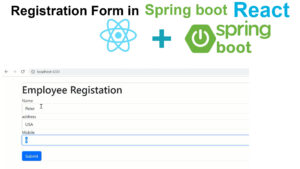In this tutorials will teach you spring boot with react how to do the Restful API to add the records in to the mysql database .Spring Boot with React use to create a full-stack web application.how to insert the records into mysql database step by step via spring boot layer architecture process using industrial standards.



Create the Package entity inside the package create the class Employee
Employee
package com.example.Registation.Entity;
import javax.persistence.*;
@Entity
@Table(name="employee")
public class Employee
{
@Id
@Column(name="employee_id", length = 45)
@GeneratedValue(strategy = GenerationType.AUTO)
private int employeeid;
@Column(name="employee_name", length = 255)
private String employeename;
@Column(name="address", length = 255)
private String address;
@Column(name="mobile", length = 20)
private int mobile;
public Employee(int employeeid, String employeename, String address, int mobile) {
this.employeeid = employeeid;
this.employeename = employeename;
this.address = address;
this.mobile = mobile;
}
public Employee() {
}
public int getEmployeeid() {
return employeeid;
}
public void setEmployeeid(int employeeid) {
this.employeeid = employeeid;
}
public String getEmployeename() {
return employeename;
}
public void setEmployeename(String employeename) {
this.employeename = employeename;
}
public String getAddress() {
return address;
}
public void setAddress(String address) {
this.address = address;
}
public int getMobile() {
return mobile;
}
public void setMobile(int mobile) {
this.mobile = mobile;
}
@Override
public String toString() {
return "Employee{" +
"employeeid=" + employeeid +
", employeename='" + employeename + '\'' +
", address='" + address + '\'' +
", mobile=" + mobile +
'}';
}
}
Create the Package Dt0 inside the package create the class EmployeeDTO
EmployeeDTO
package com.example.Registation.Dto;
import javax.persistence.Column;
import javax.persistence.GeneratedValue;
import javax.persistence.GenerationType;
import javax.persistence.Id;
public class EmployeeDTO {
private int employeeid;
private String employeename;
private String address;
private int mobile;
public EmployeeDTO(int employeeid, String employeename, String address, int mobile) {
this.employeeid = employeeid;
this.employeename = employeename;
this.address = address;
this.mobile = mobile;
}
public EmployeeDTO() {
}
public int getEmployeeid() {
return employeeid;
}
public void setEmployeeid(int employeeid) {
this.employeeid = employeeid;
}
public String getEmployeename() {
return employeename;
}
public void setEmployeename(String employeename) {
this.employeename = employeename;
}
public String getAddress() {
return address;
}
public void setAddress(String address) {
this.address = address;
}
public int getMobile() {
return mobile;
}
public void setMobile(int mobile) {
this.mobile = mobile;
}
@Override
public String toString() {
return "EmployeeDTO{" +
"employeeid=" + employeeid +
", employeename='" + employeename + '\'' +
", address='" + address + '\'' +
", mobile=" + mobile +
'}';
}
}
Create the Package Controller inside the package create the class EmployeeController
EmployeeController
package com.example.Registation.EmployeeController;
import com.example.Registation.Dto.EmployeeDTO;
import com.example.Registation.Service.EmployeeService;
import org.springframework.beans.factory.annotation.Autowired;
import org.springframework.web.bind.annotation.*;
@RestController
@CrossOrigin
@RequestMapping("api/v1/employee")
public class EmployeeController {
@Autowired
private EmployeeService employeeService;
@PostMapping(path = "/save")
public String saveEmployee(@RequestBody EmployeeDTO employeeDTO)
{
String id = employeeService.addEmployee(employeeDTO);
return id;
}
}
Create the Package Service inside the package create the one class EmployeeServiceIMPL and create one interface EmployeeService
Employee Service
package com.example.Registation.Service;
import com.example.Registation.Dto.EmployeeDTO;
public interface EmployeeService {
String addEmployee(EmployeeDTO employeeDTO);
}
EmployeeServiceIMPL
package com.example.Registation.Service.impl;
import com.example.Registation.Dto.EmployeeDTO;
import com.example.Registation.Entity.Employee;
import com.example.Registation.Repo.EmployeeRepo;
import com.example.Registation.Service.EmployeeService;
import org.springframework.beans.factory.annotation.Autowired;
import org.springframework.stereotype.Service;
@Service
public class EmployeeIMPL implements EmployeeService
{
@Autowired
private EmployeeRepo employeeRepo;
@Override
public String addEmployee(EmployeeDTO employeeDTO)
{
Employee employee = new Employee(
employeeDTO.getEmployeeid(),
employeeDTO.getEmployeename(),
employeeDTO.getAddress(),
employeeDTO.getMobile()
);
employeeRepo.save(employee);
return employee.getEmployeename();
}
}
Create the Package EmployeeRepo inside the package create one interface EmployeeRepo
EmployeeRepo
package com.example.Registation.Repo;
import com.example.Registation.Entity.Employee;
import org.springframework.data.jpa.repository.JpaRepository;
import org.springframework.data.jpa.repository.config.EnableJpaRepositories;
import org.springframework.stereotype.Repository;
@EnableJpaRepositories
@Repository
public interface EmployeeRepo extends JpaRepository<Employee,Integer> {
}then run the Back-end Spring Boot Application.
React
React is a single page frond-end application.
Install React
npx create-react-app frontend-app cd my-app npm start
create the folder components inside the components folders create the file EmployeeRegistation.js.
Install
axios use to manage the Api Requests.
npm install axios
EmployeeRegistation.js
import axios from 'axios';
import {useState } from "react";
function EmployeeRegistation()
{
const [id, setId] = useState('');
const [name, setName] = useState("");
const [address, setAddress] = useState("");
const [mobile, setMobile] = useState("");
async function save(event)
{
event.preventDefault();
try
{
await axios.post("http://localhost:8085/api/v1/employee/save",
{
employeename: name,
address : address,
mobile : mobile
});
alert("Employee Registation Successfully");
setId("");
setName("");
setAddress("");
setMobile("");
}
catch(err)
{
alert("User Registation Failed");
}
}
return (
<div class="container mt-4" >
<form>
<div class="form-group">
<label>Name</label>
<input type="text" class="form-control" placeholder="Enter Name"
value={name}
onChange={(event) =>
{
setName(event.target.value);
}}
/>
</div>
<div class="form-group">
<label>Address</label>
<input type="text" class="form-control" placeholder="Enter Address"
value={address}
onChange={(event) =>
{
setAddress(event.target.value);
}}
/>
</div>
<div class="form-group">
<label>Mobile</label>
<input type="text" class="form-control" placeholder="Enter Mobile"
value={mobile}
onChange={(event) =>
{
setMobile(event.target.value);
}}
/>
</div>
<button class="btn btn-primary mt-4" onClick={save}>Register</button>
</form>
</div>
);
}
export default EmployeeRegistation;i have attached the video link below. which will do this tutorials step by step